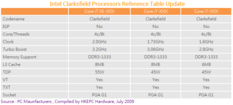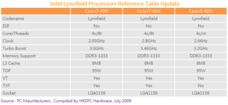- Joined
- Oct 9, 2007
- Messages
- 47,670 (7.43/day)
- Location
- Dublin, Ireland
| System Name | RBMK-1000 |
|---|---|
| Processor | AMD Ryzen 7 5700G |
| Motherboard | Gigabyte B550 AORUS Elite V2 |
| Cooling | DeepCool Gammax L240 V2 |
| Memory | 2x 16GB DDR4-3200 |
| Video Card(s) | Galax RTX 4070 Ti EX |
| Storage | Samsung 990 1TB |
| Display(s) | BenQ 1440p 60 Hz 27-inch |
| Case | Corsair Carbide 100R |
| Audio Device(s) | ASUS SupremeFX S1220A |
| Power Supply | Cooler Master MWE Gold 650W |
| Mouse | ASUS ROG Strix Impact |
| Keyboard | Gamdias Hermes E2 |
| Software | Windows 11 Pro |
Using new lows in core clock speeds, Intel is looking to give its upcoming Westmere-based Core i7 "Clarksfield" mobile quad-core processors surprisingly low rated TDPs. Apart from the rest of the known lineup of upcoming Intel processors, it is learned that Intel will initially have three mobile quad-core chips, all branded Core i7, and based on the 32 nm Clarksfield core. The three will include an Extreme Edition (XE) SKU. The clock speeds of these will be surprisingly low: ranged between 1.60 to 2.00 GHz, while having a high Turbo-Boost speed ranged between 2.80 to 3.20 GHz.
The Turbo-Boost speed is enabled when the processor powers-down some of its cores, and increases the clock speed of the cores that are available. In the process, power consumption is reduced. These chips have some very low TDPs that make them ideal for notebooks. The XE variant has a TDP of 55W, while the two lower models have rated TDP of 45W. The low-end model comes with 6 MB of L3 cache, while the higher two have 8 MB. All models have four cores with HyperThreading enabling 8 threads, and lack IGPs. They will run on the new PGA-G1 socket.
In related news, the first three Core i5/i7 "Lynnfield" processors come with rated TDP no higher than 95W. They come with Turbo-Boost Speeds ranging between 3.20 and 3.60 GHz.


View at TechPowerUp Main Site
The Turbo-Boost speed is enabled when the processor powers-down some of its cores, and increases the clock speed of the cores that are available. In the process, power consumption is reduced. These chips have some very low TDPs that make them ideal for notebooks. The XE variant has a TDP of 55W, while the two lower models have rated TDP of 45W. The low-end model comes with 6 MB of L3 cache, while the higher two have 8 MB. All models have four cores with HyperThreading enabling 8 threads, and lack IGPs. They will run on the new PGA-G1 socket.
In related news, the first three Core i5/i7 "Lynnfield" processors come with rated TDP no higher than 95W. They come with Turbo-Boost Speeds ranging between 3.20 and 3.60 GHz.


View at TechPowerUp Main Site
Last edited:




